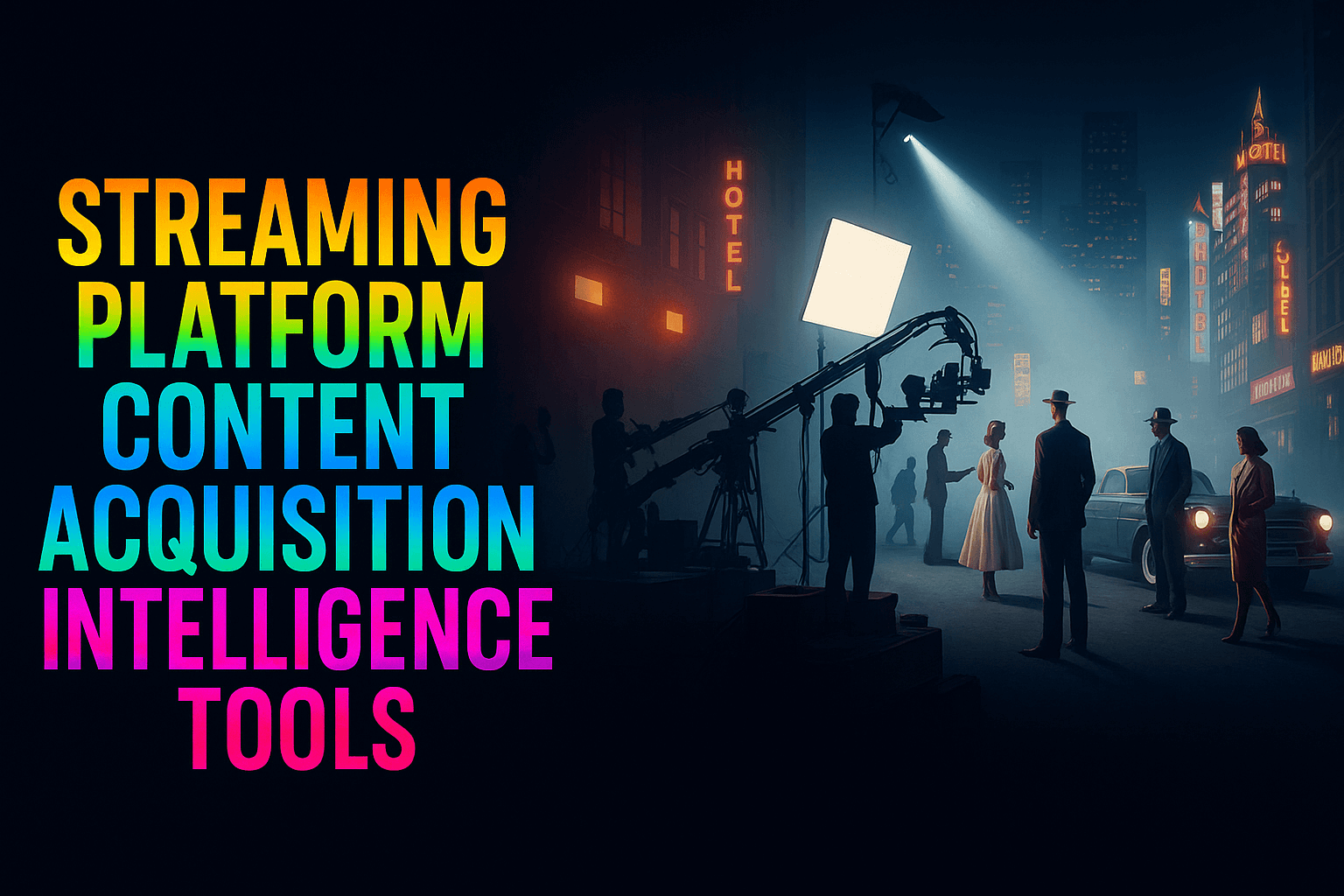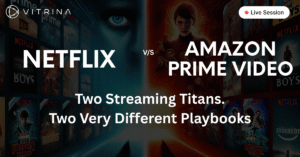The Strategic Guide to Streaming Platform Content Acquisition Intelligence Tools

Introduction
In the fiercely competitive world of streaming, success is determined by one factor above all others: the content library. The days of relying on intuition and personal relationships to build a content slate are over.
Today, executives responsible for content acquisition, from major studios to niche platforms, must operate with the precision of a data scientist. This is the era of streaming platform content acquisition intelligence tools—sophisticated platforms that provide the data and insights needed to make smart, strategic, and profitable decisions.
These are not simple directories but advanced systems designed to solve the problem of data fragmentation across the global entertainment supply chain. This article will provide a strategic framework for understanding, evaluating, and leveraging these crucial tools.
Table of content
- The Strategic Imperative for Data in Content Acquisition…
- What Are Content Acquisition Intelligence Tools?…
- Evaluating an Intelligence Tool: Key Features…
- The Vitrina Solution: A Strategic Approach to Data…
- How Vitrina Transforms the Acquisition Process…
- Conclusion: Powering Your Next Strategic Move…
- Frequently Asked Questions
Key Takeaways
| Core Challenge | Acquiring and licensing content for streaming platforms without a unified source of verified, real-time data on projects, companies, and market trends. |
| Strategic Solution | Implement an intelligence platform that provides a 360-degree view of the entertainment supply chain, from project development to release, enabling data-driven acquisition decisions. |
| Vitrina’s Role | Vitrina is a leading platform that provides real-time, verified intelligence on global film and TV projects, company profiles, and executive contacts to address the industry’s fragmentation challenge. |
The Strategic Imperative for Data in Content Acquisition
The modern M&E landscape is defined by an overwhelming volume of content and a fragmented global market. For content acquisition executives, this presents a monumental challenge.
The sheer number of projects in development, coupled with an ever-expanding list of potential partners, makes it impossible to rely on traditional, manual methods.
Without a clear data strategy, platforms risk overpaying for content, missing out on emerging hits, or failing to acquire the right content to attract and retain their target audience.
The old model involved attending major festivals and markets, relying on relationships, and sifting through an endless stream of unverified pitches. This approach is slow, inefficient, and prone to human error.
In a world where a competitor can snap up a hot project in a matter of hours, this is a significant liability. The strategic imperative for streaming platform content acquisition intelligence tools is to replace this reactive, manual process with a proactive, data-driven one.
According to a 2025 report from App inventive, AI-powered predictive analytics can help eliminate the guesswork by analyzing massive datasets—including viewing behavior, social media trends, and regional preferences—to forecast content demand before any licensing decision is made.
This transition from a market-based approach to a data-centric one is crucial. The goal is to gain full visibility into the entertainment supply chain, from the earliest stages of a project’s life to its final distribution, ensuring every acquisition decision is backed by verified intelligence.
What Are Content Acquisition Intelligence Tools?
So, what exactly are streaming platform content acquisition intelligence tools? They are a category of B2B software designed to provide executives with a comprehensive, interconnected view of the film and television market.
Unlike consumer-facing sites that track viewer behavior or general-interest data, these platforms focus on business-critical intelligence.
At their core, these tools perform several key functions: they track projects, profile companies, and map relationships. A truly effective tool offers a unified view, allowing a user to see a project, the companies involved, the executives who work there, and the historical collaboration patterns that connect them. This is the difference between having a list of credits and having a living map of the industry.
The data within these tools is typically proprietary and is sourced from a variety of public and non-public channels, then verified by human analysts.
For example, a platform might track a project from its initial development announcements, monitor its progress through pre-production and filming, and update the status as it enters post-production and distribution.
This allows a content buyer to get an early warning about a project’s availability long before it is offered to the general market. They move beyond basic show metadata to provide a deeper understanding of the business behind the content.
They can also analyze content performance and predict demand, helping executives forecast which titles will resonate with their audience.
Evaluating an Intelligence Tool: Key Features
When assessing a streaming platform content acquisition intelligence tool, it’s critical to look for features that directly address the pain points of an M&E executive. I recommend focusing on five core capabilities.
First, Project Tracking and Discovery. Can you track a film or TV show as it moves through its entire lifecycle, from development to release?
A reliable tool provides real-time updates on a project’s status, cast, crew, and vendors. This provides a critical early warning system for upcoming content and allows executives to engage in proactive outreach.
Second, Comprehensive Company Profiling. A good tool provides a deep profile of every company in the entertainment supply chain. This includes production companies, studios, distributors, and even service vendors like VFX houses and localization partners.
The best platforms offer insights into a company’s past collaborations, its financing partners, and its market focus, which is essential for due diligence and partner vetting.
Third, Executive and People Search. In an industry built on relationships, the ability to find the right person is paramount. An effective tool includes a searchable database of executives and professionals, tagged by their roles, departments, and specialties. This allows an executive to find the decision-maker for a specific project or department, bypassing the traditional gatekeepers.
Fourth, Relationship Mapping. The most powerful intelligence platforms go beyond listing data. They show the connections between people, companies, and projects. Can you see a full network of collaborations, or identify every project a specific executive has been attached to? This type of relationship intelligence is crucial for strategic business development.
Finally, consider Data Integrity and Sourcing. Is the information verified by a human team? In an industry where rumors can be mistaken for facts, having a source that fact-checks its data is non-negotiable. The reliability of your decisions is directly tied to the accuracy of your data.
The Vitrina Solution: A Strategic Approach to Data
For content acquisition executives, Vitrina is a prime example of a professional-grade streaming platform content acquisition intelligence tool. It was designed specifically to address the problem of data fragmentation across the global M&E industry.
Vitrina is not a consumer-facing platform, but a business tool that provides executives with verified, proprietary intelligence. The platform’s value proposition is its ability to connect the dots across a vast, complex market.
Vitrina’s core capabilities align perfectly with the needs of a content acquisition professional. It tracks over 500,000 film and TV projects globally, providing real-time updates on their status from development to release.
It also profiles more than 160,000 companies—from major studios to niche vendors—and maintains a verified directory of over 3 million executives, tagged by their specialties and contact information.
This deep, interconnected data set allows users to gain a comprehensive view of the market that is simply not available through manual research or public sources.
The platform’s methodology involves a human-verified approach to data, ensuring the information is accurate and reliable for high-stakes business decisions.
How Vitrina Transforms the Acquisition Process
Vitrina’s approach transforms the content acquisition process from a reactive, time-consuming effort into a proactive, data-driven strategy. The platform helps executives overcome some of their biggest pain points.
Lack of Early Warning: Content buyers often hear about new projects only when they are already being shopped to the market. Vitrina’s project tracker provides an early warning signal by monitoring projects from their earliest development stages, allowing executives to identify potential hits and engage with creators and producers long before their competitors.
Difficulty Finding the Right Partners: A content buyer may know the type of film they want to acquire but struggle to find the right distributor or rights-holder. Vitrina’s advanced search capabilities allow them to filter by genre, region, and project status to identify and vet potential partners with precision. They can find a co-production partner in a specific market, or a distributor with a track record of success in a niche genre.
Inefficient Outreach: Finding a key decision-maker is often a barrier to business development. Vitrina’s verified executive contacts directory eliminates this hurdle. An executive can find the specific person responsible for content acquisition at a major studio and get their verified contact information, making outreach more direct and effective.
By integrating this interconnected intelligence into a single platform, Vitrina empowers executives to make faster, smarter decisions that lead to a more competitive and profitable content library. Image of a dashboard showing interconnected data points: companies, projects, and executives.
Conclusion: Powering Your Next Strategic Move
In the modern M&E industry, the strategic use of data is the ultimate competitive advantage. For content acquisition leaders, embracing streaming platform content acquisition intelligence tools is no longer a luxury—it’s a necessity.
These platforms provide the unified, verified, and interconnected data needed to move beyond guesswork and make confident, profitable decisions in a fragmented global market.
By leveraging a platform like Vitrina, executives can streamline their workflows, find and vet partners with precision, and get an early warning on the content that will define tomorrow’s market.
This strategic shift from a manual to a data-driven process is what will empower platforms to build a thriving, future-proof content library and lead the market for years to come.
Frequently Asked Questions
These tools use data analytics to identify market trends, audience preferences, and emerging genres. This helps executives make informed decisions about which content to acquire based on a data-driven understanding of what their target audience wants.
Yes. Professional-grade platforms are built to provide comprehensive market coverage, including projects from independent producers, niche studios, and emerging markets, which are often overlooked by general-purpose databases.
Yes. The best tools include features for relationship mapping and company profiling. This allows you to identify and vet potential co-production partners based on their past work, genre focus, and track record.
Elite intelligence platforms employ a combination of AI and human verification to ensure the data is accurate and up-to-date. The data is often proprietary and sourced from a variety of channels, then fact-checked to ensure its reliability.















































